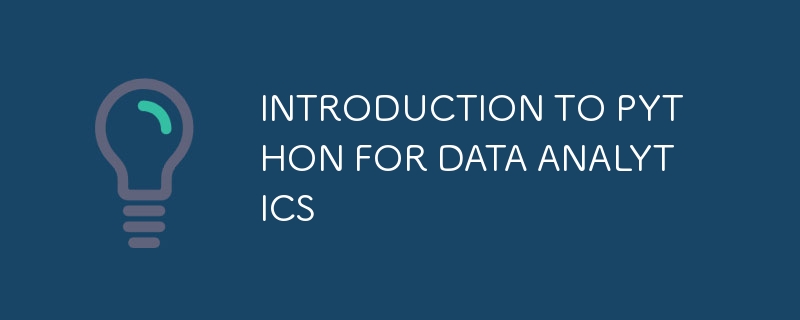Home >Backend Development >Python Tutorial >INTRODUCTION TO PYTHON FOR DATA ANALYTICS
INTRODUCTION TO PYTHON FOR DATA ANALYTICS
- Susan SarandonOriginal
- 2024-10-07 11:41:30888browse

During an engaging and informative session this week with Lux Tech Academy Kenya,we were taken through a comprehensive introducuction to Python for Data and Analytics.
First thing's first, you'll need to install Anaconda download and launch the Jupyter notebook. Here is a link to download Anaconda/Jupyter Notebooks: Anaconda/Jupyter notebooks installation
I feel like a vessel filled to the brim with a bounty of all this knowledge, from which I will share a few highlights.
Tuples refer to in-built data types which facilitate organisation of data, similar to lists but are more unique. They are defined using parantheses;my_cars= (1,2,3). Tuples represent a fixed collection of items that do not change overtime such as latitudes and longitudes. Unlike lists, tuples are not modifiable;once defined, one cannot change or alter the elements in a tuple.
Python lists also refer to in-built data systems that enable you to organise information in certain categories which are slightly different from tuples. Here is an example of a list of fruits: my_fruits=['mangos','apples','grapes']
Lists can store elements of different data types,their elements are modifiable through the use of functions such as .apend(),.remove()etc and can therefore grow dynamically in the program.
NumPy arrays also provide an efficient way of storing large data sets in Python libraries but differ with lists and tuples in the following ways: They only store elements of the same data type, they use less memory space and do not have looping processes since they support vectorised operations.
There are various processes which handle memory usage in Python, but we will majorly focus on Garbage collection.This reserves memory by removing objects that are no longer needed by programs.
1.Garbage collection can be done through:
Reference Counting: which tracks the number of references pointing to a a particular object in a Python program. When the reference count drops to zero, the memory used by the object is dropped.
2.Cyclic collection: this is similar to the latter but is used in cases where objects reference each other in a cycle.
Lastly,I will shade some light on the functions in an analysis script. A function is a reusable line of code which can be called severally to perform the same task. The basic syntax is:
`def function_name(operation)
code block
describing the function
return value
Example:
squared_list=[b**2 for b in range(1,10)]
print(squared_list)`
Output: [1,4,9,16,49,64,81]
Jupyter Notebook is very beginner friendly so I highly recommend it for this.
This is just a tip of the iceberg and I can't wait to learn more in my next class. Knowledge is power, so let's keep learning and building to mould ourselves a better future!
The above is the detailed content of INTRODUCTION TO PYTHON FOR DATA ANALYTICS. For more information, please follow other related articles on the PHP Chinese website!

